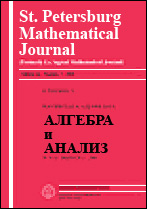|
This article is cited in 4 scientific papers (total in 4 papers)
Research Papers
Quaternionic Grassmannians and Borel classes in algebraic geometry
I. Panina, C. Walterb
a Chebyshev Laboratory, St. Petersburg State University, 14th Line V.O. 29B, 199178, Saint Petersburg, Russia
b Laboratoire J.-A. Dieudonné (UMR 6621 du CNRS), Département de mathématiques Université de Nice -- Sophia Antipolis, 06108 Nice Cedex 02, France
Abstract:
The quaternionic Grassmannian HGr(r,n)HGr(r,n) is the affine open subscheme of the usual Grassmannian parametrizing those 2r2r-dimensional subspaces of a 2n2n-dimensional symplectic vector space on which the symplectic form is nondegenerate. In particular, we have HPn=HGr(1,n+1)HPn=HGr(1,n+1). For a symplectically oriented cohomology theory AA, including oriented theories but also the Hermitian KK-theory, Witt groups, and algebraic symplectic cobordism, we have A(HPn)=A(pt)[p]/(pn+1)A(HPn)=A(pt)[p]/(pn+1). Borel classes for symplectic bundles are introduced in the paper. They satisfy the splitting principle and the Cartan sum formula, and they are used to calculate the cohomology of quaternionic Grassmannians. In a symplectically oriented theory the Thom classes of rank 22 symplectic bundles determine Thom and Borel classes for all symplectic bundles, and the symplectic Thom classes can be recovered from the Borel classes.
The cell structure of the HGr(r,n)HGr(r,n) exists in cohomology, but it is difficult to see more than part of it geometrically. An exception is HPnHPn where the cell of codimension 2i2i is a quasi-affine quotient of A4n−2i+1 by a nonlinear action of Ga.
Keywords:
simplectically oriented cohomology theory, Hermitian K-theory, Witt groups, algebraic symplectic cobordism, cell structure splitting principle.
Received: 16.10.2020
Citation:
I. Panin, C. Walter, “Quaternionic Grassmannians and Borel classes in algebraic geometry”, Algebra i Analiz, 33:1 (2021), 136–193; St. Petersburg Math. J., 33:1 (2022), 97–140
Linking options:
https://www.mathnet.ru/eng/aa1741 https://www.mathnet.ru/eng/aa/v33/i1/p136
|


| Statistics & downloads: |
| Abstract page: | 310 | | Full-text PDF : | 56 | | References: | 47 | | First page: | 39 |
|





 Contact us:
Contact us: Terms of Use
Terms of Use
 Registration to the website
Registration to the website Logotypes
Logotypes









 Citation in format
Citation in format 